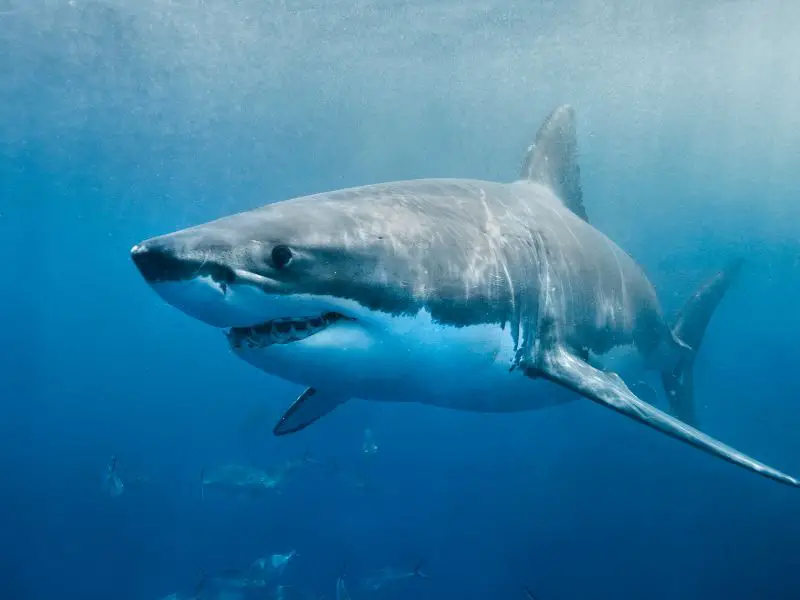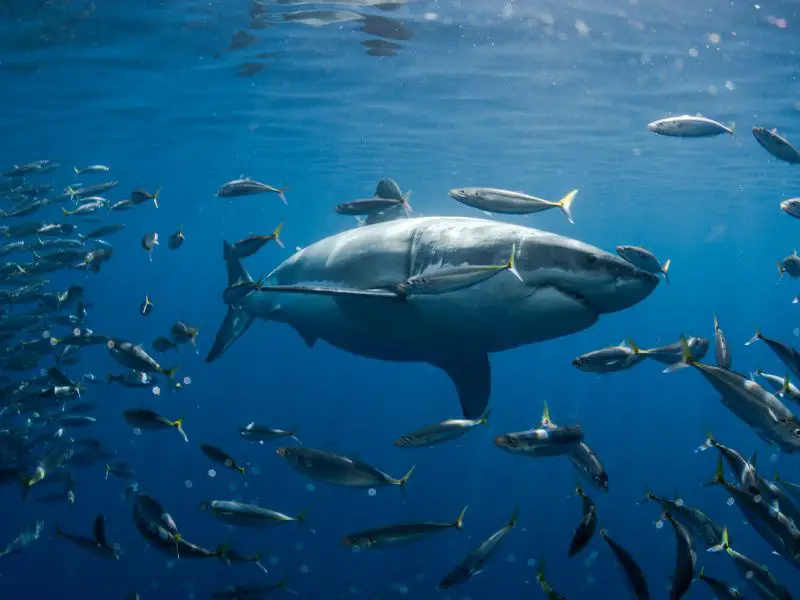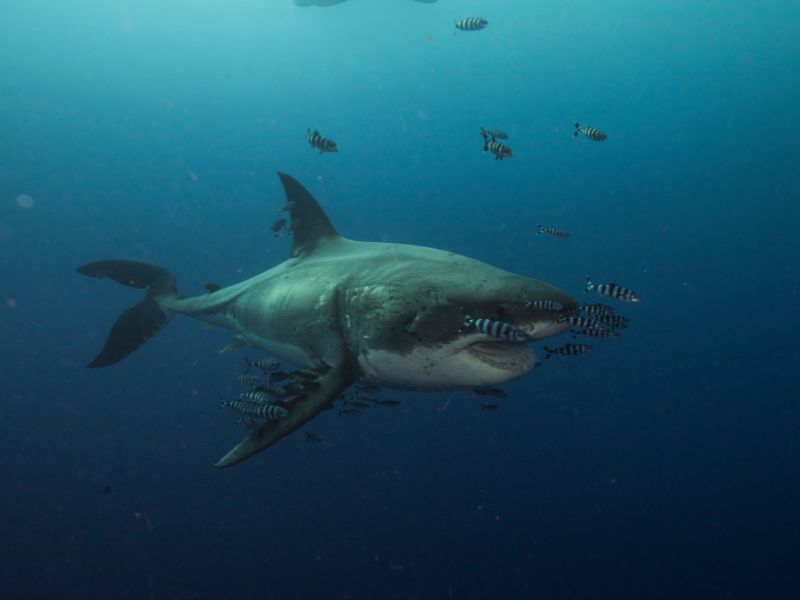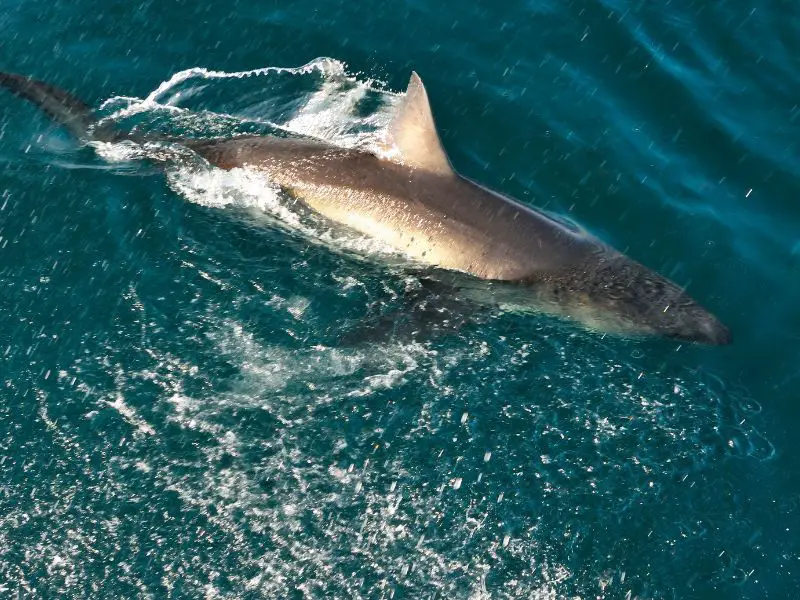Great white sharks, scientifically known as Carcharodon carcharias, dominate the vast expanses of oceans. These magnificent creatures have imposing stature, formidable jaws, and teeth as sharp as a surgeon’s scalpel. They have captured the undivided attention and ignited the imaginations of individuals across the globe.
However, due to unsafe practices and adversities, the population of these majestic great white sharks has unfortunately declined over time. In this composition, we explore the current status quo surrounding great white shark species.

Various measures, such as regulating tourism and illegal hunting, are taken to protect great white sharks. These measures include protecting their habitat from pollution and decreasing shark bycatch. We shall diligently strive to unravel the enigma that begs the question: How Many Great White Sharks Are Left in the World?
Overview of Great White Sharks
Distinguished by their imposing presence and formidable hunting prowess, they stand as majestic marine predators. Their elongated bodies can stretch up to a staggering 20 feet (6 meters). Their weight surpasses an astounding 2 tons.
These sharks possess sleek physiques, propelled by a powerful caudal fin. They also have a series of serrated teeth that strike fear into the hearts of their prey. Thriving primarily in temperate and coastal regions, great white sharks find their home in various oceans across the globe.
Historical Estimates of Population
Determining the historical population of great white sharks is challenging due to their elusive nature and the vastness of the oceans. Nevertheless, people believe that they were more abundant in the past.
However, despite this belief, today, the population of great white sharks worldwide is endangered, with fewer than 3,500 individuals remaining. People have hunted them for their jaws, fins (which are used in shark fin soup), and meat. Conservation efforts are crucial to protect these majestic predators and ensure their survival.
Decrease in Population Figures
The global population of majestic white sharks has experienced a notable decline, primarily due to anthropogenic activities. The depletion of fish stocks through excessive fishing, the loss of vital habitats, the introduction of pollutants, and the disruptive effects of climate change have all contributed to the waning numbers of these eminent predators. Such multifaceted causes have adversely affected marine ecosystems, and the major predators of the ocean lack sufficient sustenance.
Factors Affecting Great White Sharks Numbers
Great White Sharks: Overfishing Concerns Impacting Survival
The great white shark, a majestic creature, faces a looming peril in the form of overfishing. Throughout history, people have relentlessly pursued these formidable predators, coveting their mandibles, dentition, and dorsal appendages with fervor.
The insatiable demand for shark-derived merchandise, most notably the prized delicacy of shark fin soup, has spawned indiscriminate fishing methods that bear down heavily on the already beleaguered populations of these apex predators.
Loss of Habitat
The loss of suitable habitats has hurt great white sharks. Rapid coastal development, wanton destruction of crucial breeding grounds, and degradation of vital ecosystems have substantially diminished the available sanctuaries for these majestic creatures.
Related: Are Bull Sharks Dangerous? Unraveling the Truth

For instance, the annihilation of mangroves and coral reefs has resulted in a decline in prey species and disrupted the intricate food chain. This has exacerbated the predicament faced by these apex predators.
Pollution and Contamination
Pollution and contamination have cast an ominous cloud over great white sharks. Chemical pollutants, plastic debris, and oil spills have gravely damaged the delicate marine ecosystem, including these formidable sharks. The accumulation of these hazardous substances within their bodies impairs their overall health and jeopardizes their reproductive capabilities.
Great White Sharks: Climate Change Implications for Survival
Climate change’s far-reaching ramifications, including the rise in ocean temperatures and the alteration of ocean currents, have cast an uncertain future for great white sharks. Fluctuations in temperature and ocean chemistry disrupt the distribution and abundance of their prey, leading to sustenance scarcity for these majestic predators.
Furthermore, ocean warming poses a threat to their reproductive patterns and migratory routes, further exacerbating the challenges they face.
Related: Do Sharks Eat at Night?
Conservation Endeavors
In recognition of the pivotal role that great white sharks play in maintaining marine ecosystems, people have initiated diverse conservation efforts to safeguard these extraordinary creatures.
Legal Safeguards
Numerous countries have enacted stringent regulations and laws to shield great white sharks from harm. These measures encompass fishing restrictions, bans on shark finning, and the establishment of protected areas where these awe-inspiring sharks can flourish.
Marine Protected Areas
The establishment of marine protected areas (MPAs) has played a crucial and pivotal role in the preservation and safeguarding of the magnificent and awe-inspiring great white sharks and their intricate and delicate ecosystems.

These designated and demarcated regions serve as a haven and refuge, a sanctuary that ensures the security and well-being of sharks themselves and a plethora of diverse and vibrant marine species, fostering an environment where their populations can thrive, regenerate, and flourish.
Research and Monitoring
Scientists and researchers play an indispensable role in comprehending great white shark population dynamics and formulating effective conservation strategies. Through initiatives such as tagging programs, satellite tracking, and genetic analysis, they collect invaluable data to ascertain population trends, migration patterns, and genetic diversity. This advances our understanding of these magnificent creatures.
Estimating Great White Sharks Numbers
Despite the formidable challenges associated with precisely estimating great white shark numbers, scientific studies, and population modeling techniques provide invaluable insights. These methodologies amalgamate field observations, genetic analysis, and mathematical modeling to approximate population sizes. They also determine the conservation imperatives required to safeguard these remarkable creatures.
Global Distribution
They traverse the vast expanses of our planet’s waters, gracefully navigating through diverse territories spanning North America, South Africa, Australia, and select parts of Europe. These awe-inspiring creatures have left their indelible mark on both the Atlantic and Pacific Oceans. Certain locations stand out as captivating arenas where captivating encounters with these formidable predators take place more frequently.
Related: Do Sharks Make Sounds?
The Prospects for Great White Sharks
Great white sharks’ fate rests on our shared resolve to confront their myriad challenges. Through the implementation of sustainable fishing methods, the reduction of pollution, the protection of critical habitats, and the mitigation of climate change’s deleterious ramifications, we can pave the way toward the survival and resurgence of these awe-inspiring creatures.
Conclusion
In the past, they thrived abundantly in our oceans. However, a multitude of perilous circumstances now confronts their existence, leading to a decline in their population. Overfishing, the loss of their natural habitats, environmental pollution, and climate change impacts have all played significant roles in shaping the current challenging situation they face.

By demonstrating an unwavering commitment to conservation, implementing legal protection measures, and conducting rigorous scientific research, we can alter the course of events. This will secure a promising future for these extraordinary creatures.
FAQs ( Frequently Asked Questions)
The exact timeframe for the great white shark extinction is uncertain. Their population is currently at risk due to overfishing, habitat loss, pollution, and climate change. Conservation efforts and measures can safeguard their existence. By adopting sustainable practices, preserving their habitats, and addressing threats, we can prevent their extinction. This will ensure great white shark survival in our oceans.
Yes, there are still great white sharks around the world. While their population has experienced a decline due to various factors, including human activities, this species still inhabits the oceans. Efforts are being made to protect and conserve great white sharks to ensure their continued presence in our marine ecosystems.
Great white sharks are not endangered. However, they are considered vulnerable due to population declines and ongoing threats, such as overfishing, habitat loss, and climate change. Conservation efforts are crucial to maintaining populations and preventing endangered populations.
Determining the exact number of great white sharks in the world is challenging. Determining the historical population of great white sharks is challenging due to their elusive nature and the vastness of the oceans. However, estimates suggest that fewer than 3,500 individuals are remaining globally. Furthermore, these magnificent creatures are currently facing population declines, and the International Union for the Conservation of Nature (IUCN) classifies them as vulnerable to extinction primarily due to overfishing. It is essential to continue monitoring and implementing conservation measures to protect and preserve the remaining population of great white sharks.
